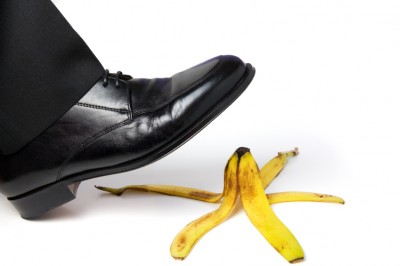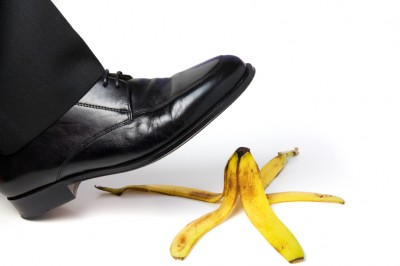In Checkout Line, Lou Bendrick cooks up answers to reader questions about how to green their food choices and other diet-related quandaries. Lettuce know what food worries keep you up at night.
———————-
 Is your green cred slipping? Dear Checkout Line,
Is your green cred slipping? Dear Checkout Line,
We try to buy local food whenever we can. Some things just seem doomed to have air miles on them, though. Is there anywhere in the U.S. that can grow bananas? Or coffee and tea?
Best,
Pat
Dear Pat,
Personal confession: If frequent-flyer miles were assigned to my coffee habit, I could probably commute from New England to Tibet for free. After doing a little research, I learned that some of the beans in my cuppa French roast this morning came from Ethiopia. According to this food-miles calculator, those beans traveled approximately 7,158 miles. I’m not going to tell you how much coffee I drink for fear of being taken into protective custody.
As you already know, many of the tropical crops dearly loved by Americans come with a whopping carbon footprint, in part due to the miles that they travel aboard planes, ships, trains, and trucks. While it would be an improvement carbon-wise to buy this stuff locally, in most parts of the United States it’s not possible to grow these crops commercially.
Well, at least not yet.
Let’s take a look at the warm-weather darlings you mentioned and I’ll give you some options to offset their mitigate their deleterious effects on our planet.
Bananas
Where they are grown: These favored phallic fruits are currently cultivated in the toasty equatorial regions of the world known as the tropics. Check out the banana wiki and scroll down to the top-banana producing nations if you want to get specific. Good news: Hawaii grows a tasty, nutritious variety of banana called an apple banana that will be available from this web site in the near future. Although this won’t help you reduce your food miles unless you live in Hawaii, you would stimulate the Aloha state’s agricultural economy. A few things: These Hawaiian bananas must be irradiated for export and although they are not organic, Hawaiian banana farmer Young Tarring assured me that they are low-spray. Meanwhile, the tropics may not be the only place producing bananas in our globally warm future: according to this article, bananas now grow in southern England.
Doom-mitigating action items: Bear in mind that food-miles are just one of the environmental problems associated with our dysfunctional food system. Other things that effect sustainability are how the food is grown and processed, so buy organic and Fair Trade bananas to assure that your bananas aren’t heavily sprayed and that the people who grow and pick them are treated with respect. But because food miles are at the top of your irk-list, I’ll suggest limiting your intake of commuter fruits to wintertime, when your access to fresh, local fruit might be limited. That said, we might brace ourselves for some banana deprivation: The most common variety of banana, the Cavendish, is likely to vanish from our future because of a blight. Ain’t monocultures grand?
More radical step: Grow your own. Hunka-hunka burnin’ lobe, calculator-wielding eco-pioneer Amory Lovins manages to grow bananas with passive solar energy in Colorado’s Rocky Mountains, so maybe there’s hope for the rest of us. Talk to your local nursery about getting a banana plant suited for your climate (you’ll want to stick to container growing if you live up North).
Coffee
Where it is grown: In parts of the world with stable, moderate temperatures, sunshine, and great soil. Check out this “bean belt” map. As is the case with bananas, you can’t buy coffee locally unless you live in Hawaii. If you’d like to support American growers anyway, surf the Internet to find organic growers there. This organic coffee farm also offers a vacation rental. (I’m just saying.) Local Harvest is a great place to find Hawaiian high-test.
Doom-mitigating action items: Buy triple-certified (organic, fair trade and shade-grown) coffee, bring your-own mug when you caffeinate on the run, and use your buzz to save the world. If the travel miles are coming between you and the enjoyment of your latté, heed your values and kick the habit. Just don’t ask me for advice on how to do this because I am draining a French press as I type.
More radical step. Move to Hawaii! Short of that, grow your own coffee shrub. According to this site, a mature plant can produce as much as two to four pounds of java per year. Okay, so that’s only a month’s worth of coffee for me, but you could always raise more than one plant and have your own micro-plantation. Downside: It could take a few years for your plant to start producing. And you can’t cruise your plantation on horseback.
Tea
Where it grows: Most of the tea that comes from Camellia sinensis plant (which produces black, green and white teas) hails from countries in Asia, Africa, and South America. Hawaii also has some growers; look for them here. Giddy news: You can buy tea from the Lower Forty-Eight! The Charleston Tea Plantation in South Carolina produces American Classic Tea, which was recently purchased by Bigelow. If you’re willing to do a little homework, you can also get tea from small, artisan growers such as this one.
Doom-mitigating action items: Buy organic, Fair Trade-certified teas. Buy in bulk to avoid excess packaging.
More radical step: You guessed it! Grow your own tea plants. As with the above grow-your-own options, a few plants won’t keep a serious habit fully supplied, but it will be an enjoyable exercise in appreciation. Here’s some help. Who knows, tea growing might even become your thing. “There will always be hobbyists and green thumbs who are growing and processing small quantities of tea using different varietals of the tea plant,” Seattle tea blogger Brett Boynton told me by email. “You find these people all over the world. Although we will never be as common as orchid people, rose people or tulip people, I am proud to be one of a handful of NW tea lovers who grows and processes a little bit of my own tea.” (A “tea blogger”--is this a great country, or what?)
Well, Pat, let’s hope, for all of our sakes, that things don’t get so hot here in the U.S. that we’re able to grow coffee in Colorado and bananas in New Jersey.
Thanks for the great question. I need to surf real estate websites in Hawaii now (so that someday maybe I’ll learn to surf for real), so I must run.
Yours,
Lou



